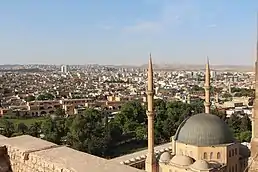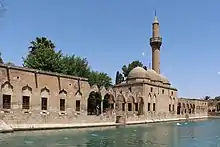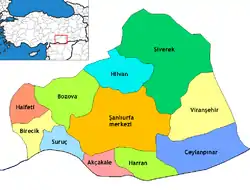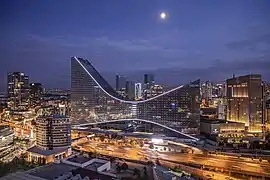Urfa
Urfa, officially known as Şanlıurfa (pronounced [ʃanˈɫɯɾfa]; known in ancient times as Edessa), is a city in southeastern Turkey and the capital of Şanlıurfa Province. Urfa is situated on a plain about 80 km east of the Euphrates River. Its climate features extremely hot, dry summers and cool, moist winters.
Urfa | |
|---|---|
Metropolitan municipality | |
| Şanlıurfa | |
Clockwise from top: View of Urfa, Urfa Castle, St. Peter and St. Paul Church, Arabi Mosque, Rizvaniye Mosque | |
| Nickname: City of Prophets[1] | |
 Urfa  Urfa | |
| Coordinates: 37°09′30″N 38°47′30″E | |
| Country | Turkey |
| Province | Şanlıurfa |
| Founded | 303/302 BC |
| Founded by | Seleucus I Nicator |
| Government | |
| • Mayor | Zeynel Abidin Beyazgül (AKP) |
| • Governor | Abdullah Erin |
| Area | |
| • District | 3,668.76 km2 (1,416.52 sq mi) |
| Elevation | 477 m (1,565 ft) |
| Population (2021) | |
| • Total | 586,733[3] |
| Time zone | UTC+3 (TRT) |
| Website | www.sanliurfa.bel.tr |
About 12 km (7 mi) northeast of the city is the famous Neolithic site of Göbekli Tepe, the world's oldest known temple, which was founded in the 10th millennium BC.[4] The area was part of a network of the first human settlements where the agricultural revolution took place. Because of its association with Jewish, Christian, and Islamic history, and a legend according to which it was the hometown of Abraham, Urfa is nicknamed the "City of Prophets."[1]
Name
For a while during the rule of Antiochus IV Epiphanes (175–164 BC) the city was named Callirrhoe or Antiochia on the Callirhoe (Ancient Greek: Ἀντιόχεια ἡ ἐπὶ Καλλιρρόης). During Byzantine rule it was named Justinopolis. Prior to Turkish rule, it was often best known by the name given it by the Seleucids, Ἔδεσσα, Édessa.
In later times, the city was known as Ruha, and with the Arabic article, it became Ar-Ruha, evolving into Urha, and eventually Urfa. Carsten Niebuhr observed that Turks called the city El-Rohha in the 18th century, although James Silk Buckingham, who later visited Urfa, disagreed and noted that all Turks, and most Arabs and Kurds in the surrounding countryside called it Urfa, while a small portion of the Christians called it as the former.[5] Despite this, the city is currently claimed to be known as Riha in Kurdish.[6] The city is also known as ܐܘܪܗܝ or Ūrhāi in Syriac and Ուռհայ or Urrha in Armenian.
Şanlı means "great, glorious, dignified" in Turkish, and Urfa was officially renamed Şanlıurfa ("Urfa the Glorious") by the Turkish Grand National Assembly in 1984, in recognition of the local resistance in the Turkish War of Independence. The title was granted following repeated requests by the city's members of parliament, eager to receive a title similar to those given to neighbouring cities Gazi (Veteran) Antep and Kahraman (Heroic) Maraş.
History
Urfa was founded as a city under the name Edessa by the Seleucid king Seleucus I Nicator in 303 or 302 BC.[7][8] There is no written evidence for earlier settlement at the site, but Urfa's favorable commercial and geographical placement suggests that there was a smaller settlement present prior to 303 BC. The indigenous Aramaic name for the site prior to the Seleucid period was Orhai or Orhay, which survives as the basis of the city's modern Turkish name.[7] Perhaps Orhai's absence from earlier written sources is due to the settlement having been small and unfortified prior to the Seleucid period.[9] Seleucus named the city after the ancient capital of Macedonia.
Prehistory
.jpg.webp)
Urfa shares the Balikh River Valley region with two other significant Neolithic sites at Nevalı Çori and Göbekli Tepe. Settlements in the area originated around 9000 BC as a PPNA Neolithic sites located near Abraham's Pool (Site Name: Balıklıgöl). They were part of a network of first settlements spanning West Asia where agriculture began. The life-sized limestone "Urfa Man" statue was found at Urfa during an excavation and is now on display at the Şanlıurfa Archaeology and Mosaic Museum.[11] The Urfa Man resembles both carvings at nearby Gobekli Tepe and statues found at 'Ain Ghazal. The village at Balıklıgöl was followed by a string of four PPNB villages on four hilltops at the Gürcütepe site. Beginning in 6200 BC small Halaf culture villages began to appear in the Balikh Valley. The typical Halaf village is 2ha with a population of 500 people surrounded by agricultural fields. By 5000 BC the entire valley was densely filled.
The region was conquered repeatedly throughout history, and has been dominated by many civilizations, including the Ebla, Akkadians, Sumerians, Babylonians, Hittites, Hurri-Mitannis, Assyrians, Medes, Persians, Ancient Greeks (under Alexander the Great), Seleucids, Armenians, Arameans, the Neo-Assyrian Osrhoenes, Romans, Sassanids, Byzantines, Arabs, Seljuqs and Ottomans.
City of Edessa
In the late 2nd century, as the Seleucid dynasty disintegrated, it became the capital of the Arab Nabataean Abgar dynasty, which was successively Parthian, Aramean/Syriac kingdom Osroene, Armenian, and Roman client state and eventually a Roman province. Its location on the eastern frontier of the Empire meant it was frequently conquered during periods when the Byzantine central government was weak, and for centuries, it was alternately conquered by Arab, Byzantine, Armenian, Turkish rulers. In 1098, the Crusader Baldwin of Boulogne induced the final Armenian ruler to adopt him and then seized power, establishing the first Crusader State known as the County of Edessa and imposing Latin Christianity on the Greek Orthodox, Assyrian Church of the East and Armenian Apostolic majority of the population.
Age of Islam
Islam first arrived in Urfa around 638 AD, when the region surrendered to the Rashidun army without resisting, and became a significant presence under the Ayyubids (see: Saladin Ayubbi), Seljuks. In 1144, the Crusader state fell to the Turkish Abbasid general Zengui, who had most of the Christian inhabitants slaughtered together with the Latin archbishop (see Siege of Edessa) and the subsequent Second Crusade failed to recapture the city.[12] Subsequently, Urfa was ruled by Zengids, Ayyubids, Sultanate of Rum, Ilkhanids, Memluks, Akkoyunlu and Safavids before Ottoman conquest in 1516.
Under the Ottomans Urfa was initially made centre of Raqqa Eyalet, laterly part Urfa (Sanjak) of the Aleppo Vilayet. The area became a centre of trade in cotton, leather, and jewellery. There was a small but ancient Jewish community in Urfa,[13] with a population of about 1,000 by the 19th century.[14] Most of the Jews emigrated in 1896, fleeing the Hamidian massacres, and settling mainly in Aleppo, Tiberias and Jerusalem. There were three Christian communities: Syriac, Armenian, and Latin. According to Lord Kinross,[15] 8,000 Armenians were massacred in Urfa in 1895. The last Neo-Aramaic Christians left in 1924 and went to Aleppo (where they settled in a place that was later called Hay al-Suryan "The Syriac Quarter").[16]
First World War and after
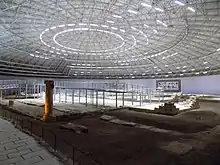
During the First World War, Urfa was a site of the Armenian and Assyrian genocides, beginning in August 1915.[17] By the end of the war, the entire Christian population had been killed, had fled, or was in hiding.
The British occupation of the city of Urfa started de facto on 7 March 1919 and officially de jure as of 24 March 1919, and lasted until 30 October 1919. French forces took over the next day and lasted until 11 April 1920, when they were defeated by local resistance forces before the formal declaration of the Republic of Turkey on 23 April 1920).
The French retreat from the city of Urfa was conducted under an agreement reached between the occupying forces and the representatives of the local forces, commanded by Captain Ali Saip Bey assigned from Ankara. The withdrawal was meant to take place peacefully, but was disrupted by an ambush on the French units by irregular Kuva-yi Milliye Şebeke Pass on the way to Syria, leading to 296 casualties among the French.
.jpg.webp)
Modern Urfa presents stark contrasts between its old and new quarters.
Religious significance
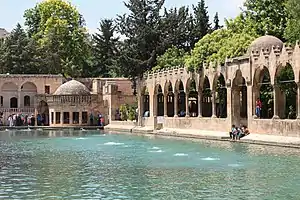
According to some Jewish and Muslim sources, Urfa is Ur Kasdim, the hometown of Abraham, the grandfather of Jacob whom God named Israel.[18] This identification was disputed by Leonard Woolley, the excavator of the Sumerian city of Ur in 1927 and scholars remain divided on the issue. Urfa is also one of several cities that have traditions associated with Job.
For the Armenians, Urfa is considered a holy place since it is believed that the Armenian alphabet was invented there.[19]
Politics
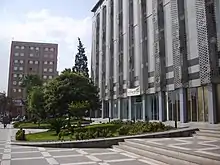
It is a stronghold of the governing Justice and Development Party. However, in the 2009 local elections, the city elected an independent, Ahmet Eşref Fakibaba, as mayor.[20]
Demographics
Ethnicity
The ethnic demographics of the city have shifted over the centuries. In ancient times, the region was mixed with Greeks, Arabs, Syrians, and Armenians.[5] At the time of the First Crusade, the majority of the population were either Armenian or Syriac Christians. By the beginning of the 21st century Urfa had a very mixed population, ethnically and religiously. In 1918, Woodrow Wilson, the American president at the time, requested information on the ethnic demographics of the region. Through an urgent request from the Ministry of the Interior, in late 1918, the mutasarrifate of Urfa reported that there were roughly 33 thousand Turks, 12 thousand Arabs, 27 thousand Kurds, 5.5 thousand Armenians, 3 thousand Assyrians, and 5 hundred Jews in the central Urfa kaza (which also includes the settlements in vicinity of the city), totaling to almost 81 thousand people.[21] The Armenian and Assyrian Genocides, undertaken by Ottoman Government troops and Ottoman sponsored militias such as the special organisation,[22] led to the death or ethnic cleansing of much of the Christian population of Urfa and the surrounding region. Following the establishment of the Republic of Turkey, most of the remaining non-Muslim population left the city due to continued persecution.[23] The urban Muslim population, mainly Turks, migrated to other parts of the country, and a large rural population (mostly of Kurdish, Arab, and to a lesser extent Turkmen origin) settled in the city. Today, the city is mainly composed of Arabs and Turkmens, along with some Kurds.[24]
Language
In early 19th century, the dominant language of the city was reported to be Turkish, the only language heard in the bazaars,[25] while Hebrew, Armenian, Syriac, Kurdish, Arabic, and Persian were also noted to be spoken. Armenians were observed to speak Turkish to strangers, while Assyrians spoke Arabic.[5]
Cuisine
As the city of Urfa is deeply rooted in history, so its unique cuisine is an amalgamation of the cuisines of the many civilizations that have ruled in Urfa . It is widely believed that Urfa is the birthplace of many dishes, including Raw Kibbé (Çiğ Köfte), that according to the legend, was crafted by the Prophet Abraham from ingredients he had at hand.[26] The walnut-stuffed Turkish dessert crepe (called şıllık) is a regional specialty.[27]
Many vegetables are used in the Urfa cuisine, such as the "'Ecır," the "Kenger," and the "İsot", the legendary local red capsicum that is a smaller and darker cultivar of the Aleppo pepper that takes a purplish black hue when dried and cured.
Unlike most of the Turkish cities that use different versions of regular butter in their regional cuisine, Urfa is, together with Antep, Mardin and Siirt a big user of clarified butter, made exclusively from sheep's milk, called locally "Urfayağı" ("Urfabutter").
Transport

Şanlıurfa GAP Airport is located about 34 km (21 mi) northeast of the city and has direct flights to Istanbul, Ankara and Izmir. Construction of the first phase of a planned four-route, 78 km network of trolleybus lines began in late 2017,[28] and the first of 10 bi-articulated trolleybuses built by manufacturer Bozankaya was received in September 2018.[29] However, work on additional vehicles was suspended because of various problems,[30] and in 2020 the single vehicle delivered in 2018 remained the only trolleybus completed.[31] A revised date for the eventual opening of the first line has yet to be set.[31]
Climate
Urfa has a hot-summer Mediterranean climate (Köppen: Csa, Trewartha: Cs). During the summer months, temperatures often exceed 40 °C (104 °F) while rainfall is almost non-existent. Winters are cool and relatively wet, frost is common along with very sporadic snowfall. Spring and autumn are warm and moderately dry.
| Climate data for Urfa (1991-2020, extremes 1929–2020) | |||||||||||||
|---|---|---|---|---|---|---|---|---|---|---|---|---|---|
| Month | Jan | Feb | Mar | Apr | May | Jun | Jul | Aug | Sep | Oct | Nov | Dec | Year |
| Record high °C (°F) | 21.6 (70.9) |
25.5 (77.9) |
29.5 (85.1) |
36.4 (97.5) |
40.3 (104.5) |
44.1 (111.4) |
46.8 (116.2) |
46.2 (115.2) |
43.9 (111.0) |
37.8 (100.0) |
30.8 (87.4) |
26.0 (78.8) |
46.8 (116.2) |
| Average high °C (°F) | 10.6 (51.1) |
12.5 (54.5) |
17.5 (63.5) |
23.1 (73.6) |
29.6 (85.3) |
35.7 (96.3) |
39.5 (103.1) |
39.0 (102.2) |
34.5 (94.1) |
27.7 (81.9) |
18.9 (66.0) |
12.4 (54.3) |
25.1 (77.2) |
| Daily mean °C (°F) | 6.2 (43.2) |
7.5 (45.5) |
11.8 (53.2) |
16.8 (62.2) |
22.8 (73.0) |
28.8 (83.8) |
32.6 (90.7) |
32.0 (89.6) |
27.4 (81.3) |
21.2 (70.2) |
13.1 (55.6) |
7.9 (46.2) |
19.0 (66.2) |
| Average low °C (°F) | 3.0 (37.4) |
3.6 (38.5) |
7.0 (44.6) |
11.3 (52.3) |
16.6 (61.9) |
21.9 (71.4) |
25.4 (77.7) |
25.0 (77.0) |
20.8 (69.4) |
15.8 (60.4) |
8.9 (48.0) |
4.8 (40.6) |
13.7 (56.7) |
| Record low °C (°F) | −10.6 (12.9) |
−12.4 (9.7) |
−7.3 (18.9) |
−3.2 (26.2) |
2.5 (36.5) |
8.3 (46.9) |
15.0 (59.0) |
16.0 (60.8) |
10.0 (50.0) |
1.9 (35.4) |
−6.0 (21.2) |
−6.4 (20.5) |
−12.4 (9.7) |
| Average precipitation mm (inches) | 81.0 (3.19) |
66.3 (2.61) |
57.9 (2.28) |
44.7 (1.76) |
26.2 (1.03) |
5.8 (0.23) |
2.0 (0.08) |
4.0 (0.16) |
8.1 (0.32) |
24.6 (0.97) |
51.2 (2.02) |
78.7 (3.10) |
450.5 (17.74) |
| Average rainy days | 11.73 | 10.40 | 10.27 | 9.40 | 7.77 | 1.77 | 0.43 | 0.33 | 1.47 | 5.73 | 7.17 | 10.87 | 77.3 |
| Average relative humidity (%) | 74 | 72 | 61 | 51 | 43 | 27 | 22 | 24 | 28 | 43 | 57 | 72 | 48 |
| Mean monthly sunshine hours | 117.8 | 135.6 | 189.1 | 225.0 | 288.3 | 345.0 | 359.6 | 325.5 | 276.0 | 220.1 | 159.0 | 108.5 | 2,749.5 |
| Mean daily sunshine hours | 3.8 | 4.8 | 6.1 | 7.5 | 9.3 | 11.5 | 11.6 | 10.5 | 9.2 | 7.1 | 5.3 | 3.5 | 7.5 |
| Source 1: Devlet Meteoroloji İşleri Genel Müdürlüğü[32] | |||||||||||||
| Source 2: Weatherbase[33] | |||||||||||||
Main sights

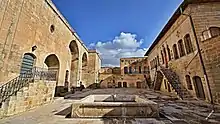
- Urfa castle – built in antiquity, the current walls were constructed by the Abbasids in 814 AD.
- The legendary Pool of Sacred Fish (Balıklıgöl) where Abraham was thrown into the fire by Nimrod. The pool is in the courtyard of the mosque of Halil-ur-Rahman, built by the Kurdish Ayyubids in 1211 and now surrounded by the attractive Gölbaşı-gardens designed by architect Merih Karaaslan. The courtyard is where the fishes thrive. A local legend says seeing a white fish will open the door to the heavens.
- Rızvaniye Mosque – a more recent (1716) Ottoman mosque, adjoining the Balıkligöl complex.
- 'Ayn Zelîha – A source nearby the historical center, named after Zulaykha, a follower of Abraham.
- The Great Mosque of Urfa was built in 1170, on the site of a Christian church the Arabs called the "Red Church," probably incorporating some Roman masonry. Contemporary tradition at the site identifies the well of the mosque as that into which the towel or burial cloth (mendil) of Jesus was thrown (see Image of Edessa and Shroud of Turin). In the south wall of the medrese adjoining the mosque is the fountain of Firuz Bey (1781).
- Ruins of the ancient city walls.
- Eight Turkish baths built in the Ottoman period.
- The traditional Urfa houses were split into sections for family (harem) and visitors (selâm). There is an example open to the public next to the post office in the district of Kara Meydan.
- The Temple of Nevali Çori – Neolithic settlement dating back to 8000BC, now buried under the Atatürk Reservoir, with some artefacts relocated above the waterline.
- Göbekli Tepe – The world's oldest known temple, dated 10th millennium BC (ca 11,500 years ago).[4]
Gallery
See also
- Cilicia War
- Urfa Resistance
- Chronology of the Turkish War of Independence
- Cities of the ancient Near East
- Haliliye
- Karaköprü
- Göbekli Tepe
References
- "'City of prophets' drawing faith tourists". Hürriyet Daily News. 20 November 2014. Retrieved 29 October 2020.
- "Area of regions (including lakes), km²". Regional Statistics Database. Turkish Statistical Institute. 2002. Retrieved 5 March 2013.
- "Turkey: Major cities and provinces". citypopulation.de. Retrieved 8 February 2015.
- "The World's First Temple - Archaeology Magazine Archive". archive.archaeology.org. Retrieved 22 March 2018.
- The Oriental Herald, and Journal of General Literature Vol. XII. London. 1827. pp. 39, 40, 47, 48. Retrieved 9 September 2022.
- Avcýkýran, Dr. Adem (ed.). "Kürtçe Anamnez, Anamneza bi Kurmancî" (PDF). Tirsik. p. 57. Retrieved 17 December 2019.
- Schnusenberg, Christine (2010). The Mythological Traditions of Liturgical Drama: The Eucharist as Theater. New York: Paulist Press. p. 116. ISBN 978-0-8091-0544-1.
- Murray, Alan V. (2006). The Crusades: An Encyclopedia. ABC-CLIO. p. 378. ISBN 978-1-57607-862-4.
- Segal, J. B. (2001) [1970]. "I. The Beginnings". Edessa:'The Blessed City' (2 ed.). Piscataway, New Jersey, United States: Gorgias Press. p. 5. ISBN 0-9713097-1-X.
It is certainly surprising that no obvious reference to Orhay has been found so far in the early historical texts dealing with the region, and that, unlike Harran, its name does not occur in cuneiform itineraries. This may be accidental, or Orhay may be alluded to under a different name which has not been identified. Perhaps it was not fortified, and therefore at this time a place of no great military significance. With the Seleucid period, however, we are on firm historical ground. Seleucus I founded—or rather re-founded—a number of cities in the region. Among them, probably in 303 or 302 BC, was Orhay.
- Renfrew, Colin; Boyd, Michael J.; Morley, Iain (2016). Death Rituals and Social Order in the Ancient World: Death Shall Have No Dominion. Cambridge University Press. p. 74. ISBN 9781107082731.
- "TOMBOLARE – Urfa Man / Balıklıgöl Statue, c. 10,000 BC". Tumblr. Retrieved 22 March 2018.
- Roberts, J. M. (1996). "II/4. Frontiers and neighbours". The Penguin History of Europe. London: Penguin Books. pp. 162–163. ISBN 978-0-14-026561-3.
- "Edessa". Jewish Encyclopedia. 1906.
- "Interview with Harun Bozo". The Library of Rescued Memories. Central Europe Center for Research and Documentation.
- Kinross, Lord (1977). The Ottoman Centuries, The Rise and Fall of the Turkish Empire. United States: Harper Perennial. pp. 560. ISBN 0-688-08093-6.
- Joseph, John (1983). Muslim-Christian Relations and Inter-Christian Rivalries in the Middle East: The Case of the Jacobites in an Age of Transition. United States: State University of New York Press. pp. 150. ISBN 0-87395-612-5.
- armenian-genocide.org
- "Ur Kasdim: Where is Abraham's Birthplace? - TheTorah.com". www.thetorah.com. Retrieved 10 March 2021.
- Öktem, Kerem (2003). Creating the Turk's Homeland: Modernization, Nationalism and Geography in Southeast Turkey in the late 19th and 20th Centuries (PDF). Harvard: University of Oxford, School of Geography and the Environment, Mansfield Road, Oxford, OX1 3TB, UK. Archived from the original (PDF) on 9 November 2013. Retrieved 19 January 2013.
For Armenians, the city has a great symbolic value, as the Armenian alphabet was invented there, thanks to a group of scholars and clergy headed by Mesrop Mashtots in the 5th century
- "Kurds in Southeast Anatolia celebrate DTP's boost in votes". Today's Zaman. 31 March 2009. Archived from the original on 8 April 2014. Retrieved 7 February 2013.
- Aslan, Ahmet. "URFA'DA ASAYİŞ VE GÜVENLİK (1913-1918)" (PDF). İstanbul Üniversitesi. Retrieved 7 June 2022.
- Bloxham, Donald (2003). "The Armenian Genocide of 1915–1916: Cumulative Radicalization and the Development of a Destruction Policy". Past & Present. 181 (181): 141–191.
- Biner, Zerrin Özlem (2019), p371. States of Dispossession: Violence and Precarious Coexistence in Southeast Turkey
- Kamer, Hatice (30 May 2015). "Şanlıurfa'da oylar partilere değil adaylara". BBC News Türkçe (in Turkish). Retrieved 7 June 2022.
- London Magazine, Volume 7. London. 1827. p. 546. Retrieved 9 September 2022.
- From Kâtib el Bağdadî in p.196Urfa'da Pişer Bize de Düşer, Halil & Munise Yetkin Soran, Alfa Yayın, 2009, Istanbul ISBN 978-605-106-065-1
- "Şanlıurfa'nın 'şıllık' tatlısı tescillendi". Sabah. Retrieved 8 November 2018.
- "Trolleynews [regular news section]". Trolleybus Magazine. Vol. 54, no. 340. UK: National Trolleybus Association. July–August 2018. p. 155. ISSN 0266-7452. OCLC 62554332.
- "Trolleynews". Trolleybus Magazine. Vol. 55, no. 343. UK: National Trolleybus Association. January–February 2019. p. 38. ISSN 0266-7452.
- "Trolleynews". Trolleybus Magazine. Vol. 55, no. 344. UK: National Trolleybus Association. March–April 2019. p. 75. ISSN 0266-7452.
- "Trolleynews". Trolleybus Magazine. Vol. 56, no. 349. UK: National Trolleybus Association. January–February 2020. p. 35. ISSN 0266-7452. OCLC 62554332.
- "Resmi İstatistikler: İllerimize Ait Mevism Normalleri (1991–2020)" (in Turkish). Turkish State Meteorological Service. Retrieved 7 August 2021.
- "Urfa, Turkey Travel Weather Averages (Weatherbase)".
